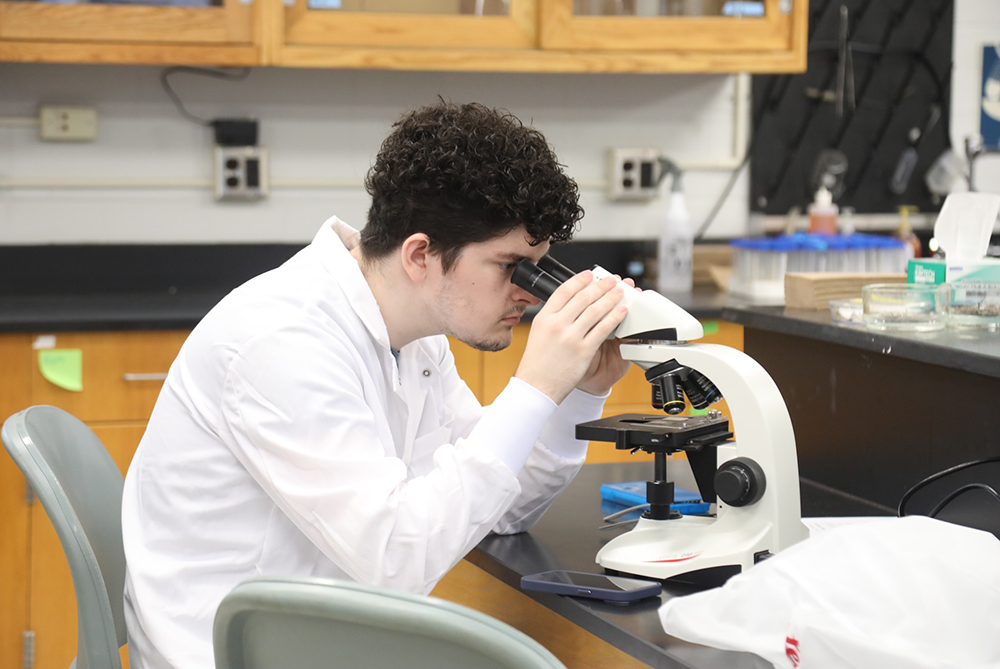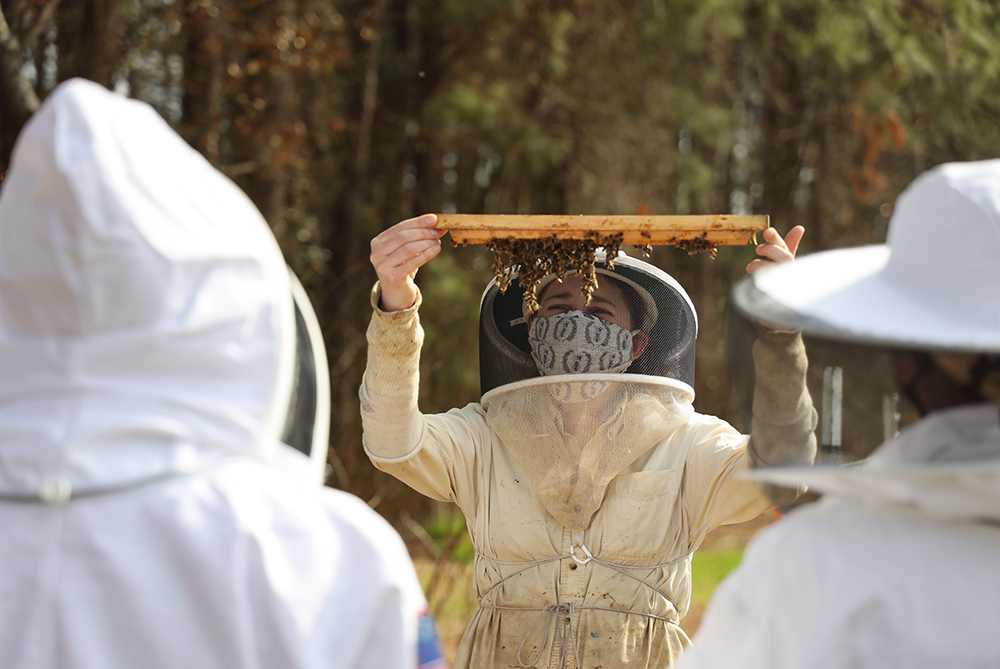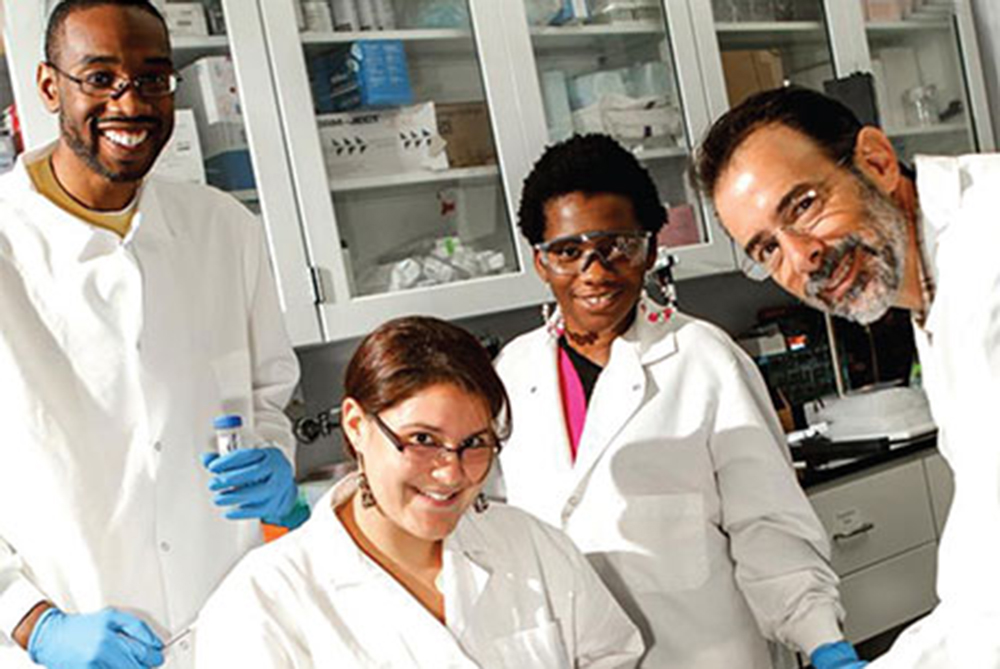Nematology, Applied Microbiology and Fermentation
Biotech Center Research
Screening Photorhabdus luminescens for Antibacterial Properties Using a Modified Version of the Kirby-Bauer Method.
Floyd L. Inman, III*; Len Holmes
The aim of this work was to observe and determine the bacteriocidal properties of Photorhabdus luminescens. A modified version of the Kirby-Bauer method was used to screen this bacterium for bacteriocidal properties against a collection of 28 different bacteria. The collection of bacteria used contained bacterial species with different cellular morphologies and Gram stain reactions. The measurements of the zones of sensitivity were used to observe and determine these bacteriocidal properties. The Kirby-Bauer method was slightly modified to achieve the aim of this work. The modification consisted of using blank, sterile disks that had been inoculated with a liquid culture of mid-log phased P. luminescens. From these 28 different species of bacteria, 11 bacterial species was determined to be sensitive to P. luminescens.
Trehalose as a Carbohydrate Source for the Culture and Stability of the Phase I Variant of Photorhabdus luminescens.
Floyd L. Inman, III; Len Holmes*
Photorhabdus luminescens is a Gram-negative, bioluminescent, pigment producing enteric bacterium that is pathogenic to insects. This bacterium has the ability to undergo phase variation. The phase I variant exists as a mutualistic symbiont in the digestive tract of the nematode, Heterorhabditis bacteriophora, and plays a critical role in the life-cycle of this commercially-reared beneficial entomopathogenic nematode. Only phase I cells support development of the nematode. It is critical to understand the stability requirements of this bacterial variant. The bacterium receives its requirements (i.e. carbohydrates) from the hemolymph of the larval insect host. The sugar trehalose, an α-1,1 linked non-reducing disaccharide of glucose, is important in the physiology of microbes, insects and nematodes. Trehalose has been shown to be the most abundant sugar found within hemolymph. Acting as a physical and chemical protectant, trehalose has been implicated with thermal stress, dehydration and osmotic protection. It is also a store of glucose for glycolysis. We propose that trehalose will best support, in vitro, the stability of the phenotypic traits of the phase I variant. The traits monitored in this work are (1) bioluminescence (2) the production of the red anthroquinone–derived pigment and (3) culture pH.
Using α–Amylase from Bacillus subtilis as a Catalyst for the Production of Sweet Potato Biofuels.
Floyd L. Inman, III; Heather Walters*; Len Holmes
Bacillus subtilis is an aerobic, Gram-positive, endospore-forming bacterium that has the ability to produce and secrete the hydrolyzing carbohydrate enzyme, α-amylase. α–Amylase is an enzyme that is used in various industries to rapidly degrade complex polysaccharides (e.g. starches) into smaller oligosaccharides. α–Amylase from B. subtilis is currently being investigated as a potential source for producing fermentable sugars from the remnants of sweet potatoes. These fermentable sugars will be bioconverted into ethanol as a source for biofuels. B. subtilis was cultured in a 2 L Sartorius-stedim Biostat ® A+ Plus fermentation system. An optical density probe was used to measure bacterial growth within the culture. α–Amylase activity was assayed throughout the culturing period to determine the time-frame of maximum α–amylase production. Enzyme production was stimulated 5-fold and higher by the addition of high concentrations of starches.
Using α–Amylase from Bacillus subtilis as a Catalyst for the Production of Sweet Potato BiofuelsWireless Control of Fed-Batch Fermentation Systems.
Heather Walters*, Eric Moreau, Sunita Singh, Floyd L. Inman, III, Len D. Holmes
Bioreactor operation requires continuous monitoring of fermentation parameters and real-time control over bioreactor devices. Remote monitoring and control of the bioreactor's computer via the Internet avoids the necessity of personnel being continually on-site during operation. A Sartorius Biostat A Plus® bioreactor (2 Liter) and its computer control system were interfaced with the commercial software GoToMyPC®. The bioreactor was equipped with all controls for monitoring during experiments: oxygen sensor, pH sensor, temperature sensor and agitation. Other calibrations (media inflow & outflow, antifoam additions) were calibrated with the system’s peristaltic pump adjusted for time. Remotely controlled night-vision web cameras allowed monitoring capability of the glass fermentation vessel. A Wi-Fi connection via wireless router allowed multiple system connections to the host computer. The window screen of the main computer can be accessed from any wireless device with an Internet connection. The secured Internet Protocol (IP) address assures that the system can only be controlled by the main users. This wireless interface permits the remote control of fed-batch fermentations and other culturing protocols.
Fermentation is the term used to describe any process for the production of a product by means of the culture of microorganisms or cells. Fermentation is often thought of as the "first step" in many biotechnology processes. Organic biological molecules, microbes, therapeutics, enzymes, antibiotics and vaccines are all produced using fermentation. Fermentation products can be either:
- The cells themselves. This is referred to as biomass production.
- A cell or microorganism's own metabolite referred to as a product from a natural or genetically improved strain.
- A cell or microorganism's foreign product from recombinant DNA technology or genetic engineering.
This fermentation technology applies chemistry, biochemistry, microbiology, molecular biology, computer science, engineering, physics and business. It is our goal to establish a UNCP Biotechnology Facility at the research/bench scale, expandable to the scale of a manufacturing pilot plant.
EXAMPLES OF FERMENTATION PRODUCTS
- Amino acids Lipids
- Antibacterial agents Nucleotides
- Antifungal agents Organics
- Carbohydrates Pharmaceuticals
- Protein hormones Steroids
- Enzymes Monoclonal antibodies
- Foods
- Vitamins
MODES OF FERMENTATION
- Batch fermentation is carried out in a closed-system bioreactor. The sterilized nutrient medium is seeded (inoculated) with living cells. The mixture is incubated with stirring under specific conditions and the culture grows. Typically nutrients are not added during the growth. Often, oxygen (aerobic microbes), an acid or base to control pH and an antifoam agent are added. The composition of the medium and the concentration of biomass and nutrients change with time. The cell composition of the culture can be described in four phases. Fed-batch fermentation is a variation of the above process in which liquid streams of nutrients are continuously added in predetermined amounts as the fermentation process progresses. This will have the effect of extending the stationary phase and allowing us to obtain additional product.
- Continuous Fermentation is considered to be an "open system" where nutrients are continuously added to the system and product is continuously removed. The cell growth is kept at steady state using chemostat or turbostat technology.
Other Research

Molecular Biology

Campus Garden & Apiary
